The Dance of Material
[Published in Studio Potter, V34 #2, pp 16-17, June 2006]
[Some additional images here]
We all come to pottery with different assumptions about material. An artist I once met in a New York City elevator said, “I want to get into porcelain because I want to get really messy.” I remember thinking, porcelain is the clean clay! Other potters assume that their clay has to be really rough, or found and dumped in thirteen-ton truckloads, or refined and delivered in twenty-five pound plastic bags. A few years ago when I was firing my wood kiln, some helping friends brought their six-year-old daughter. She had looked forward to the visit, hoping we could make things together as we had before, but I had cleaned up the studio so friends could sleep there during the firing. She was momentarily disappointed, but as we moved wood, stoked the kiln, and talked, she quietly gathered some red Virginia clay soil, a bucket of water, and a flat log, and began to make little pinched teacups.
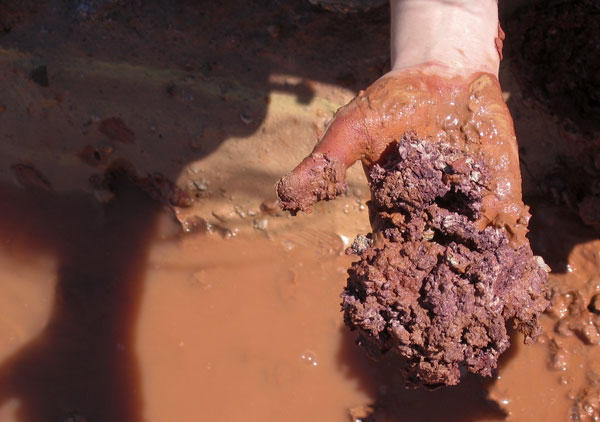
Stancills Red Clay
Emma found a meeting point between her hand, her desire, and the available material. The first time I went to Stancills clay mine I felt like her, six years old. The earth spoke directly to my fingers and the pit of my stomach; I just wanted to gather lumps of raw material and make something. I had had samples kicking around my studio for a year and knew from testing that it fired to stoneware temperatures, but I wanted to work below the radar of good craftsmanship. I wasn’t looking to replace an industrial material, but for a new dance partner. The clay I chose was short and sandy; its limitations forced a new choreography between imagination and essence. I had to understand the very basics of form and motivation, stripping away the tricks and virtuosic fingerings on the wheel. Industrially produced clays are easy-to-use, predictable clays, but purity harbors blandness. They lack the personality of the earth and the specificity of my east coast location. The delicacy allowed with a refined material is different from the vehemence required of this found clay.
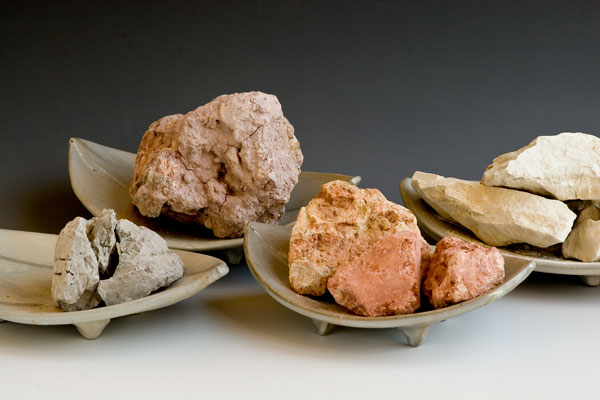
The Stancills Clay Candyshop
At the opening for our exhibit in the Stancills mine, a European woman told me that using this clay was beyond her capability because she thought she had to mix tons at a time. A Texan potter got samples and his first step was to ball mill the material. Some kids I met at the mine walked around asking, “Where’s the clay?” They just needed to see the mud at their feet as clay, kneel down, and start to pinch pots. The Texan was looking through his glasses of refinement. And the European woman needed a permission slip to work in dishpan-size batches.
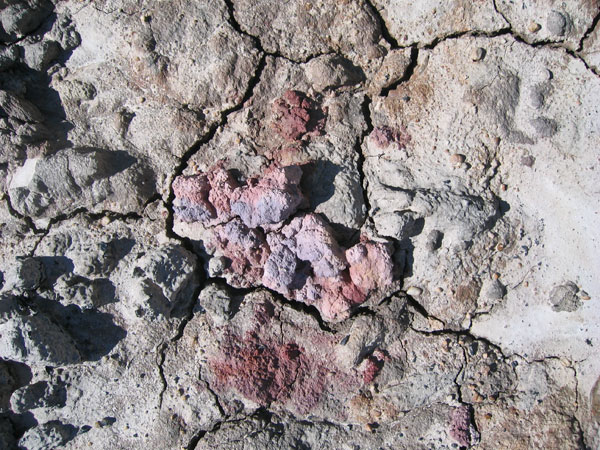
Looking Down, Standing on Clay
Every step of my work is a re-centering of an essential idea in response to divergent materials. When I started my studio in 1984, I felt that people were seduced by decoration while I wanted to find expression through form, so I only used a white clay and clear glaze. Each variation from there has been a step along a path towards a more direct expression of the delicate relationship between the imagination, the material and the hand. As the material shifts, altered resolutions are demanded. For instance, I found that the commercial porcelain I first used was too smooth and dense, so I began to add small percentages of a sandy, barely rocky white clay from Vermont. When that ran out I added irregularly-sized silica sand found at the base of a conveyor belt in a West Virginia mine explored during a house-hunting trip. When I found the Stancills clay, its sandy, short nature required a passionate pursuit of form with no dilly-dallying. The material itself called forth an untutored approach. There was no time to fool around and I loved the results.
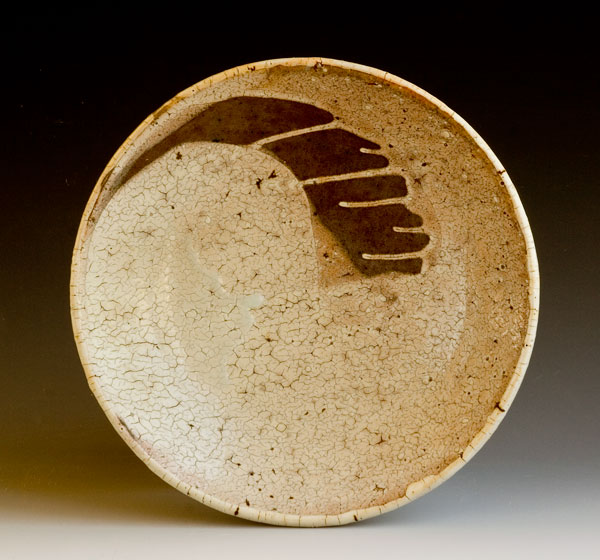
Bowl h 2" w 8", Catherine White
Red Stancills clay, white slip, celadon glaze
In the 1990’s I made a series of pots out of rough white clay. I faceted them, and when I cut through the wall by mistake I just slapped the cut patch back on the pot, as I had seen in some antique Korean ginger jars. While good craftsmanship said that this was unacceptable, I managed to remember that there are no mistakes in art, just opportunities. Once I was no longer striving for dexterous performance on the wheel, I could spiral towards dexterous maneuverings of the imagination and the heart. When a material and technique are mastered, the pursuit often loses its vitality. The edge of discovery can be reclaimed by changing an element of approach, such as incorporating a cantankerous unrefined clay. I test my hand against the nuances of color, smoothness, and plasticity. In the moment of action I choose to emphasize one aspect or another. The material becomes the boundary within which I wake up and take nothing for granted.
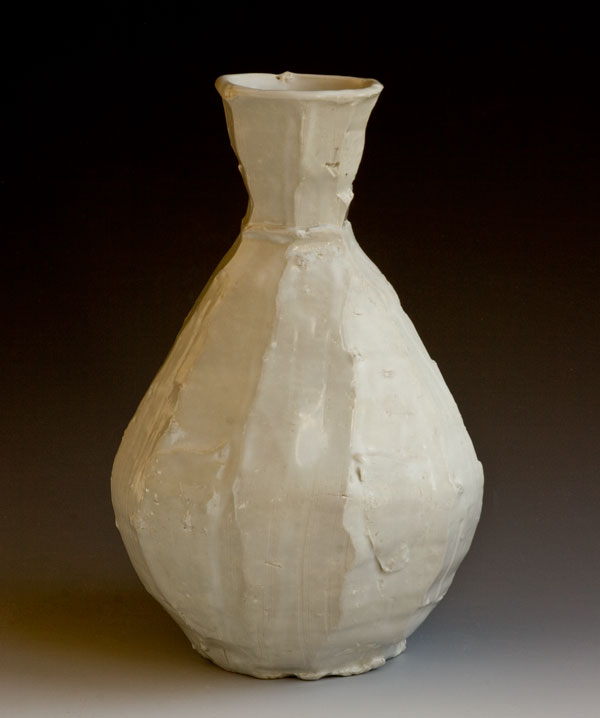
White Faceted Vase with Patch, h 9.5" w 6", Catherine White
When I unstack my kiln, the pots have reached the end of what they might have been. Now they are what they are, ready to be transformed through the next step of use. In working with the latest batch of red Stancills clay I found I needed to see the fired results before I went any further with wet work. My hands had to hold the vitrified mix of clay to see its specific response to glaze, heat, and atmosphere. I had to embrace the recent fired work to know where I stood. It’s not just the raw clay and the wet work, but how both interact with my palette of slip and glaze. At bisque the clay is so absorbent I have to adjust my application of glaze. The glazing builds on the tension of the dance. I capture the moment that connects my hand to wet clay, drying slip, and thinned glaze. It is not a known equation but an intuitive balance, accessed by sensation. It reminds me of walking in the dark on my rural driveway. I can see the stars in the sky, but they don’t help me navigate. When I step off onto the grass it is quiet and wet, so I change direction, maneuvering for the solid crunch of basalt gravel. By feeling my way alertly—with dancing feet—I know I’m on the right path.
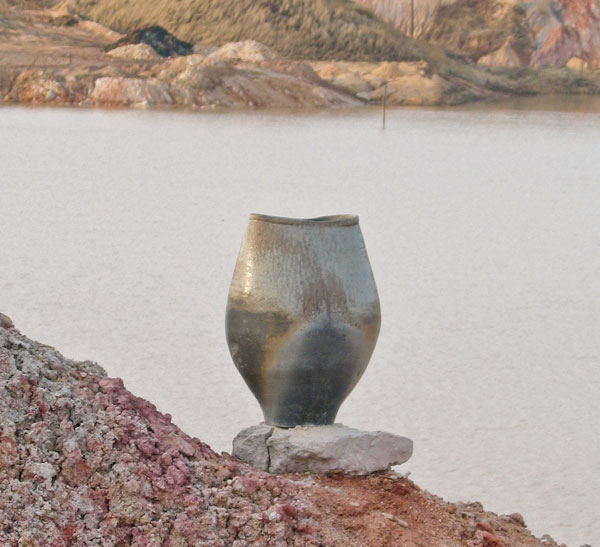
Torso Vase against Stancills Lake
h 20" w 14" d 11", Catherine White
Woodfired white Stancills
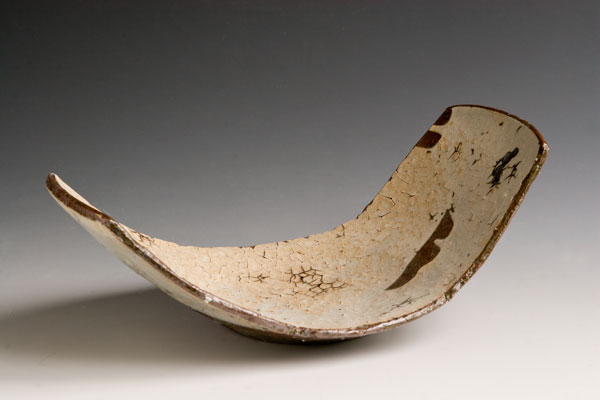
Potato Chip Plate h 3.5" w 10.5" d 6.5"
Catherine White
Red Stancills clay, white slip, celadon glaze
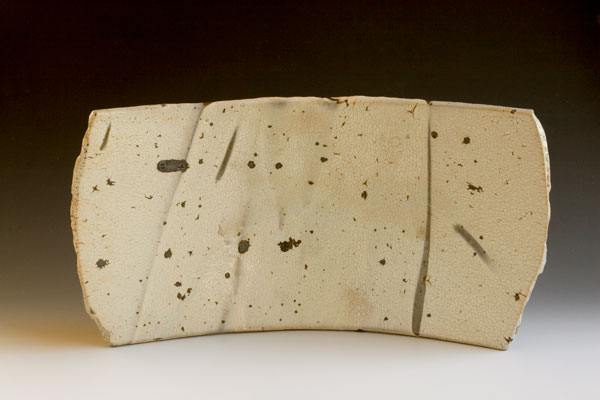
Swoop Platter (interior), h 5" w 17" d 9"
Catherine White
Red Stancills clay, white slip, celadon glaze